What is SNACK*?”
SNACK* is the creation of New York mom and SNACK*s Executive Director, Jackie Ceonzo. In 2003, after being unable to find a fulfilling program for her son, Joey, she worked with a team of professionals to create a place where any child, despite their abilities, can socialize and enjoy activities while learning practical skills in a collaborative, fun, and welcoming environment. At SNACK*, children of ALL abilities are welcome including those with no diagnosis. ALL SNACK* activities are open to the general public.”
– SNACK*’s website
My role as the communications intern
- Used research and writing skills to create and edit weekly blogs posted on SNACK*’s website
- Utilized graphic design skills to create event invitations and package inserts for company products
- Collaborated with a web developer to make SNACK*’s website more user-friendly and visually appealing
- Employed editing skills to write and revise grant proposals
Read some of my blogs
Getting on Track: Autism and Fitness
Meeting all of the needs of an individual with autism can be a difficult task. Parents try to do everything they can to care for their children, however, it’s easy to get wrapped up in providing for a child’s special needs, and forget to address their physical fitness needs.
While therapy is extremely important, exercise is often overlooked in its favor. The reality is that everybody needs some type of physical activity, and individuals with autism are no exception to that.Studies show that individuals with Autism Spectrum Disorder are less active than those without it, and while research also shows that people on the spectrum need and benefit from physical activity, many parents don’t know how to introduce their children to exercise.
There are very few fitness programs for those on the spectrum, and many physical education teachers and professionals lack understanding of the physical, emotional and sensory needs necessary to provide accommodations.
This is why SNACK*’s sports and fitness lessons taught by trained staff provide great opportunities for special needs children/teens/adults and their families.
“Once again, we all need to remember that these kids are still kids. I can remember when I realized we had a little boy, a son, not just a disabled child with autism and a seizure disorder. When I had my second son, it became so apparent what my older boy was missing in his life: sports, swimming and other forms of exercise. Having my younger “neurotypical” boy involved in all kinds of activities, it became apparent that he may not need all of the structure, but his brother sure did!!,” says Jackie Ceonzo Executive Director and Founder, SNACK & Friends, Inc.
However, there are many characteristics of Autism Spectrum Disorder that can make participating in physical activity difficult.
According to the National Center for Biotechnology Information (NCBI), children with ASD are more likely to have higher deficits in motor abilities- such as balance, postural stability, coordination, and motor dyspraxia- when compared to children without ASD. In addition, individuals with autism may have sensory sensitivity that can make visual, auditory and tactile stimuli in gyms or other recreational settings overwhelming.
It can also be hard for individuals with ASD to participate in sports or games with other children because of social anxiety, trouble communicating, interacting with others and difficulty sharing.
Participation in regular physical activity not only establishes healthy habits, lowers body mass index (BMI), and improves cardiovascular function, but it also can be a fun and/or therapeutic way to reduce many types of negative behaviors associated with autism.
According to the NCBI, a meta-analysis of 16 studies suggested that, on average, exercise interventions led to a 37% improvement in overall symptomatology of autism, specifically, behavioral and academic improvements.
Behavioral improvements include: reduction of stereotypical, aggressive or self-injurious behaviors, and hyperactivity. In terms of academic improvements, individuals with ASD were more academically responsive and on-task, and were less disruptive.
Along with its swimming program, SNACK*’s teen and 21+ sports and fitness classes provide great opportunities for individuals on the autism spectrum to exercise, have fun and learn good habits. These innovative socialization and recreational programs provide teens and adults with the opportunity to interact with their peers and be themselves.
SNACK*’s Teen Fitness class is comprised of a rotation of yoga, sports, and movement throughout the semester.
Yoga teaches members relaxation techniques in a low sensory environment. Every member is able to go at his/her pace and work on different positions and breathing exercises that help teach members to self-regulate.
During the Sports class, members get to experience team building activities, from different team sports to challenging obstacle courses. Activities require communication in order to succeed. The class is designed so that all can participate and learn how to work as a team, a skill that will generalize into other areas of life.
SNACK*’s 21+ program also includes yoga and sports classes, along with an exercise class. Exercise is taught by a personal trainer and focuses on each individual’s physical strength in order to set and achieve individual goals. The goal of this class is to stress the importance of daily exercise to achieve overall good health and wellness.
SNACK* Founder Jackie Ceonzo encourages all parents with children on the spectrum to “be reasonable in your expectations. On day one, try to run a short distance once or twice and call it a day. End on a high note – short, sweet, successful. Our son has gone from choking in the water to swimming, from ignoring the basketball to making free throws, from sitting home stimming to community walking and learning streets signs. It can be done!”
For more information about SNACK*’s sports and fitness classes visit our program guide.
Sources:
Swimming and Autism
What do you think about when you hear the word “water?” For most people, the images of a relaxing beach, serene lake or flowing river are the first things that come to mind. However, for the parents of children with autism, the word is associated with much more concerning imagery.
This concern is derived from the statistics that show a trend in drowning amongst individuals on the spectrum. According to the National Autism Association (NAA), the mortality rate is twice as high for the ASD population than it is for the general population, which is attributed in large part to drowning. That is why SNACK has offered swim programming for individuals with autism since our inception.
NAA reports that between 2009 and 2011, accidental drowning accounted for approximately 91% of total U.S. deaths reported in children with autism ages 14 and younger subsequent to wandering/elopement.
The Interactive Autism Network disclosed that 32% of parents reported a “close call” with a possible drowning when their kids ran off from a safe environment. From 2009 to 2011, 68% of children were found in a nearby lake, pond, river, creek, or pool following elopement. The intense draw many children on the spectrum feel towards water is theorized to be due to the unique multi-sensory experience it offers them, or even the calmness of areas around water.
For the sake of drowning prevention alone, it is of the utmost importance that kids with autism learn how to swim. However, not only can an enjoyable activity such as swimming prevent drowning, but it also has a host of other psychological and physiological benefits for people on the spectrum.
This is because water reduces body weight and therefore helps loosen up tight muscles and alleviate stress. This feeling can be extremely soothing for children who find it hard to regulate their bodies. The pressure of water against their skin is comforting as kids play, and many parents report that their autistic children are more tolerable towards touch and cope with everyday stress better after swimming. In fact, the gentle, rhythmic movements of swimming are similar to self-stimulatory behavior, such as flapping hands, and can help distract people with autism as well and reduce this repetitive behavior.
LEARNING TO SWIM AT SNACK
Swimming has also been shown to improve coordination and cognitive processing. When children take swimming lessons, they work on concentration, attention span, impulse control, and their ability to follow directions. The energy required to swim can reduce hyperactivity and improve a child’s ability to focus on tasks after the fact. Swimming can even help children with ASD improve their speech because they practice oral articulation when blowing bubbles in the water and controlling their breathing.
Swimming can also provide people on the autism spectrum an outlet to improve their social skills and self-esteem. According to We Rock the Spectrum Kid’s Gym, when kids with ASD swim in groups or interact one-on-one with an instructor, they learn how to share toys and participate in cooperative and competitive play while having the choice to interact at a level that is comfortable for them. Having autistic children engage in these social situations can make them more at ease around other people, which can in turn build self-confidence and expand their interpersonal relationships.
Just one of SNACK*’s many success stories is relayed in a SNACK* Story written by the parents of a child named Jack who was positively impacted by his time in the swim program.
“When Jack first started his swim lessons at SNACK, I’m not sure which one of us was more nervous. It was about 6 months in when he would finally get his hair wet. The teachers were very patient, they knew just when to push and when to give him a little space. The positive reinforcement in their words and the high-fives definitely impacted Jack. He felt like he was doing something good and started feeling proud of himself. They really had the technique he needed and thanks to them he can now swim!”
CLICK HERE TO SUPPORT OUR SWIM PROGRAMMING
Sources:
http://nationalautismassociation.org/wp-content/uploads/2012/01/Lethal-Outcomes-In-Autism-Spectrum-Disorders_2012.pdf
https://www.newswise.com/articles/drowning-remains-a-top-cause-of-death-for-children-with-autism-says-usciences-ot-prof
https://texasswimacademy.com/the-key-benefits-of-swimming-for-children-on-the-autism-spectrum/
https://www.werockthespectrumkidsgym.com/swimming-is-a-great-form-of-therapy-for-children-on-the-spectrum/
Sometimes You Don’t Need to Speak to Be Heard: Art and Autism
Our ability to communicate verbally is something we often take for granted. We seldom consider how hard it would be to express ourselves without speech. Even more rare is how often we consider the fact that for some, this life is a reality. One of the indications of autism is impaired social communication, meaning people on the spectrum cannot always express their wants and needs effectively. One third of people with ASD are nonverbal, but communication does not always have to come verbally. Even without spoken language, individuals with autism can engage with the world in their own distinct ways. Studies show that art programming can help individuals with autism overcome this hurdle, and that is why SNACK is proud to offer art as part of SNACKtivities
WATCH: See Some of Our Artists In Action
Art is not usually the first thing that comes to mind when thinking about ways to help special needs individuals express themselves, especially since the notion that people on the spectrum are “uncreative” is still a major misconception. In fact, many people with ASD have an incredible affinity for visualizing thoughts, or “thinking in pictures.” So why must those with autism translate these visual thoughts into verbalizations to explain their worlds when visual communication comes so much more naturally to them? Art can be a comfortable way for people with ASD to communicate thoughts and feelings without words.
Along with increased self-expression, self-esteem, and social behavior, art can have a host of other hidden benefits. Making art is composed of many more tasks than just the completion of a single project. It requires many little decisions such as what to create and what materials to use, along with the actions of finding materials, working on the project, cleaning up after, and sharing the art with others when it’s finished. If the project is based on a task, it could also require following all the directions correctly. These simple actions all aid in developing self-management and organizational abilities, focus, cognition, and increasing imagination and symbolic thinking.
WATCH: SNACK teams up with Josephine Herrick Project for Photo Art Class
Hands-on art can also help individuals with autism hone their fine motor skills, visual-spatial discrepancies and hand-eye coordination. People on the spectrum can have varying degrees of difficulty with fine motor skills that may include anything that relies on using small muscles in the hands. It’s also possible for art to help increase tolerance for unpleasant stimuli and channel self-stimulating behavior into a more functional and creative outlet. An enjoyable activity such as art creation makes it easier to tolerate textures and smells an autistic person might otherwise avoid. Repeatedly confronting the stimuli can help desensitize them and help them cope with similar unpleasant sensations in everyday life.
SNACK*’s understanding of the importance of self-expression, confidence and skill learning for special needs children has lead it to incorporate art classes into its Snacktivities. SNACK*’s art classes emphasize collaborative theme-based projects, focus participants on appropriate use of different media, hones fine motor skills, and allow teens to take pride in the finished project.To find out more about SNACK*’s art program or other Snacktivities, visit its program guide here, or sign up for a free trial by filling out this form on SNACK*’s website.
DONATE TO SUPPORT SNACKTIVITIES HERE
Sources:
https://the-art-of-autism.com/how-low-budget-art-projects-can-enhance-the-lives-of-children-with-autism-and-other-learning-differences/https://the-art-of-autism.com/educating-autism-art-and-creativity-to-engage-an-autistic-child-in-the-classroom/http://blog.stageslearning.com/blog/autism-art-therapyhttps://profectum.org/motor-development-autism-affects-motor-skills/https://aaep.osu.edu/sites/aaep.osu.edu/files/Educator%20Toolkit.pdfhttps://www.verywellhealth.com/what-is-nonverbal-autism-260032https://www.salon.com/2018/10/21/how-to-build-self-esteem-in-autistic-children-and-why-its-so-important/https://the-art-of-autism.com/artist-profile-teenager-zalie-copeland/
Read more of my blogs
More Than Just a Snack
Handling the Holidays
Facing the Future: “What Will Happen to My Child When I’m Gone?”
From Beaches to Backpacks: Navigating the New School Year with a Special Needs Child
Package insert graphics
In addition to having programs for children with special needs, SNACK* also has a 21+ program for adults. Inspired by the owner’s son Joe, “Cup of Joe” is a coffee brand sold and produced by members enrolled in the adult program. During my internship, I had the opportunity to design some package inserts for these coffee products.



